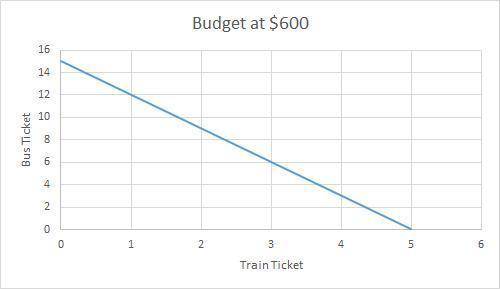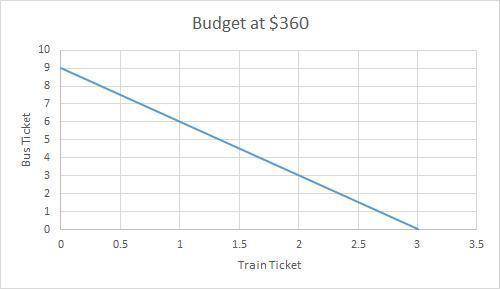 6
6 the first thing to note is since one gallon= 60 miles then 1/2 gallon= 30 miles, now I know 1/2 is not an answer but it is easiest to decrease in moderate amounts. 1/2 gallon= 48 Km so we are close, and 1/2=0.5 so if we brought it down to 0.42 we would have 25.2 miles and 25.2 miles = 40.32. The question wants to know the approximate number and 40.32 is the closest we are going to get so the answer is 0.42
question 3
80 + 65x ≤ 425
Step-by-step explanation:
First of all we know that the 425 must be greater than or equal to the other side, so the symbol to show that would be ≤. We also know that the forklift is a fixed price by the words 'each day'. And the to hire a single crew member would be $65 unless there are more crew workers, which would be multiplied with the 65.
question 4
Jimthompson5910Expert
Part A
Yes y is a function of x. Specifically the equation is y = x^5
For any given input, there is exactly one output
Notice how if x = 1 then y = x^5 = (1)^5 = 1
Notice how if x = -1 then y = x^5 = (-1)^5 = -1
Notice how if x = -2 then y = x^5 = (-2)^5 = -32
Notice how if x = 2 then y = x^5 = (2)^5 = 32
In general,
x^5 = x*x*x*x*x
there are five copies of x multiplied
A more specific example
3^5 = 3*3*3*3*3
there are five copies of '3' multiplied
Part B
All we do is replace x with 4 and use PEMDAS to simplify
f(x) = 2x+12
f(4) = 2(4)+12
f(4) = 8+12
f(4) = 20
The value of f(4) is 20
What does it mean? It is the total cost of renting the bowling lane for 4 hours. If you rent it for four hours, then you'll pay a total of $20.
The portion 2x = 2*4 = 8 is the variable cost which depends on how long you play. The more hours, the more the variable cost goes up
The fixed cost is 12. This is always fixed as this is the price to get in the door. If you play for 0 hours, but somehow got in the door, then you still pay $12
In total, variableCost+fixedCost = 8+12 = 20 = totalCost
 6
6 the first thing to note is since one gallon= 60 miles then 1/2 gallon= 30 miles, now I know 1/2 is not an answer but it is easiest to decrease in moderate amounts. 1/2 gallon= 48 Km so we are close, and 1/2=0.5 so if we brought it down to 0.42 we would have 25.2 miles and 25.2 miles = 40.32. The question wants to know the approximate number and 40.32 is the closest we are going to get so the answer is 0.42
question 3
80 + 65x ≤ 425
Step-by-step explanation:
First of all we know that the 425 must be greater than or equal to the other side, so the symbol to show that would be ≤. We also know that the forklift is a fixed price by the words 'each day'. And the to hire a single crew member would be $65 unless there are more crew workers, which would be multiplied with the 65.
question 4
Jimthompson5910Expert
Part A
Yes y is a function of x. Specifically the equation is y = x^5
For any given input, there is exactly one output
Notice how if x = 1 then y = x^5 = (1)^5 = 1
Notice how if x = -1 then y = x^5 = (-1)^5 = -1
Notice how if x = -2 then y = x^5 = (-2)^5 = -32
Notice how if x = 2 then y = x^5 = (2)^5 = 32
In general,
x^5 = x*x*x*x*x
there are five copies of x multiplied
A more specific example
3^5 = 3*3*3*3*3
there are five copies of '3' multiplied
Part B
All we do is replace x with 4 and use PEMDAS to simplify
f(x) = 2x+12
f(4) = 2(4)+12
f(4) = 8+12
f(4) = 20
The value of f(4) is 20
What does it mean? It is the total cost of renting the bowling lane for 4 hours. If you rent it for four hours, then you'll pay a total of $20.
The portion 2x = 2*4 = 8 is the variable cost which depends on how long you play. The more hours, the more the variable cost goes up
The fixed cost is 12. This is always fixed as this is the price to get in the door. If you play for 0 hours, but somehow got in the door, then you still pay $12
In total, variableCost+fixedCost = 8+12 = 20 = totalCost
attached graph
b) 600 - 120 x 3 = 240 disposable income for bus
then 240 / 40 each bus ticket = 6 bus tickets
Total trips 3 train + 6 bus = 9 trips
c) if budget is cut down to 360
to do 9 trips it will have to buy only bus tickets entirely to continue doing 9 trips
Explanation:


I think this is the answer I hope this can help you
Step-by-step explanation:
1) 3 gallons=36 miles
16 gallons=?
so it will be


or you can do like this
1 gallons=12 miles so if 16 gallons multiply with 12 it will be 192
2)2 hours=$28.50
? =$99.75
so it will be


so it will be 7 hours
3) 4.5 km= 5 hours
? =60 hours


the answer will be 54 kilometer
4) $9.60=3cm
$22.40=?


7 cm
5) $145.50=50 miles
$552.90=?


190 miles
6)$239.85=359
$1.95=?


2.92 liter
7)
220=60 hours
?=3 hours


11 miles
8)1 gallon= $17.50
8.2 gallon=?

$143.50
9)7cm=2 minute
? =13 minute


45.5 cm
10)17=4 acres
? =244 acre


1037 kg
11) 1= $2.85
4.4=?

$12.54
12)
$2.50=5 oz
$32.50=?


65 oz
 1
1  1
1  1
1 attached graph
b) 600 - 120 x 3 = 240 disposable income for bus
then 240 / 40 each bus ticket = 6 bus tickets
Total trips 3 train + 6 bus = 9 trips
c) if budget is cut down to 360
to do 9 trips it will have to buy only bus tickets entirely to continue doing 9 trips
Explanation:


 1
1 
It will provide an instant answer!
